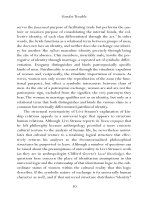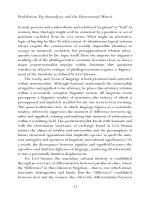GENDER TROUBLE 148
Bạn đang xem bản rút gọn của tài liệu. Xem và tải ngay bản đầy đủ của tài liệu tại đây (20.8 KB, 1 trang )
Subversive Bodily Acts
words, we know these drives as “causes” only in and through their
effects, and, as such, we have no reason for not identifying drives with
their effects. It follows that either (a) drives and their representations
are coextensive or (b) representations preexist the drives themselves.
This last alterative is, I would argue, an important one to consider,
for how do we know that the instinctual object of Kristeva’s discourse
is not a construction of the discourse itself? And what grounds do we
have for positing this object, this multiplicitous field, as prior to signification? If poetic language must participate in the Symbolic in order
to be culturally communicable, and if Kristeva’s own theoretical texts
are emblematic of the Symbolic, then where are we to find a convincing “outside” to this domain? Her postulation of a prediscursive corporeal multiplicity becomes all the more problematic when we discover
that maternal drives are considered part of a “biological destiny” and
are themselves manifestations of “a non-symbolic, nonpaternal causality.” 12 This pre-Symbolic, nonpaternal causality is, for Kristeva, a semiotic, maternal causality, or, more specifically, a teleological conception
of maternal instincts:
Material compulsion, spasm of a memory belonging to the species
that either binds together or splits apart to perpetuate itself, series of
markers with no other significance than the eternal return of the
life-death biological cycle. How can we verbalize this prelinguistic,
unrepresentable memory? Heraclitus’ flux, Epicurus’ atoms, the
whirling dust of cabalic, Arab and Indian mystics, and the stippled
drawings of psychedelics—all seem better metaphors than the theory of Being, the logos, and its laws.13
Here, the repressed maternal body is not only the locus of multiple drives, but the bearer of a biological teleology as well, one which,
it seems, makes itself evident in the early stages of Western philosophy,
in non-Western religious beliefs and practices, in aesthetic representations produced by psychotic or near-psychotic states, and even in
avant-garde artistic practices. But why are we to assume that these
113









